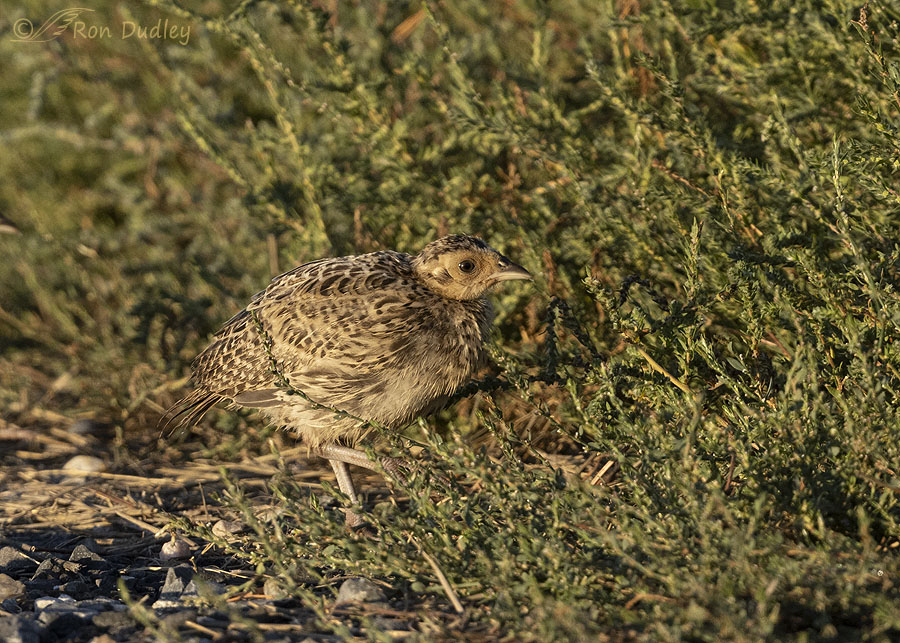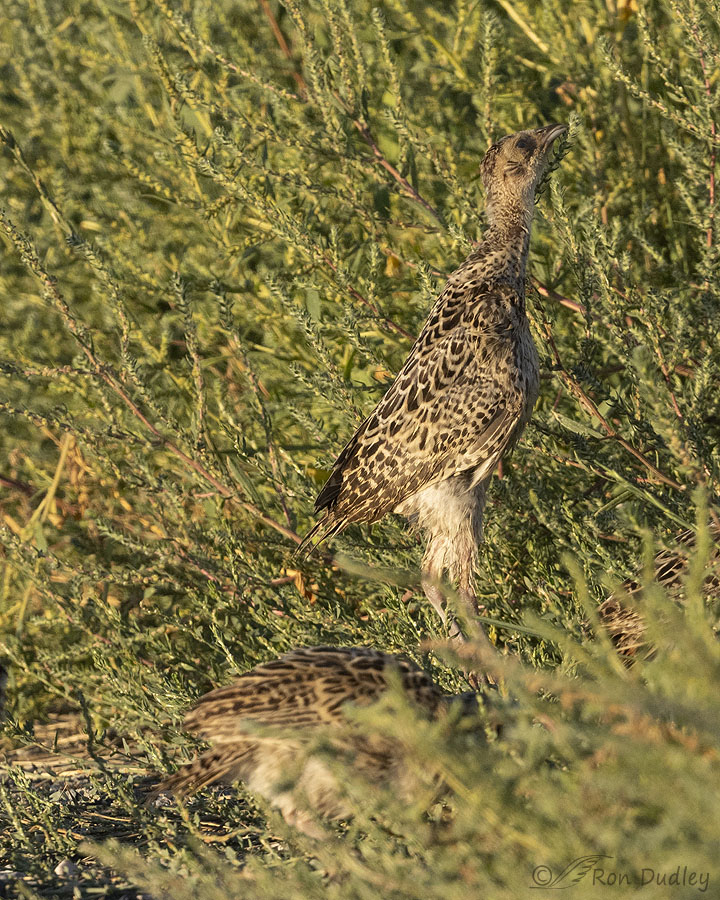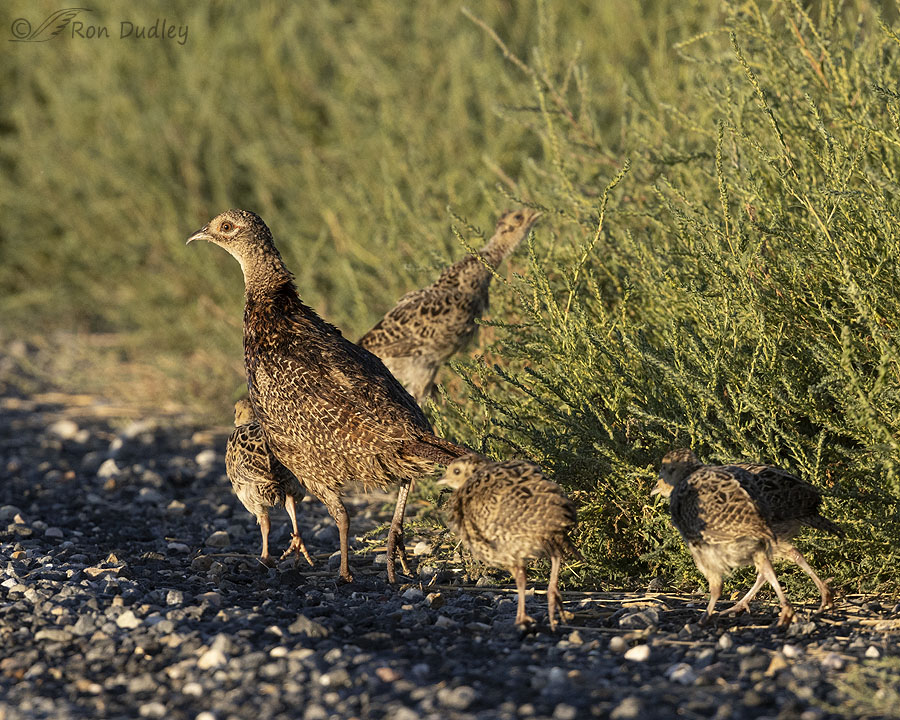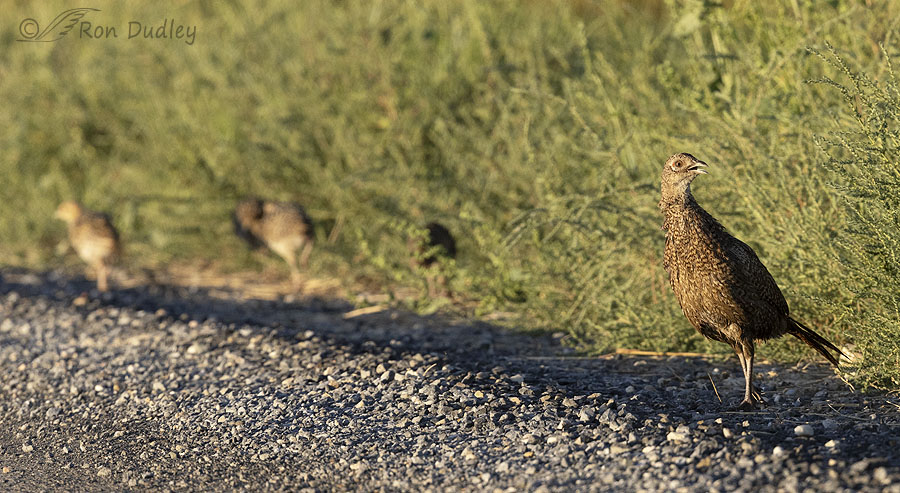Surprised the heck out of me.

1/1600, f/9, ISO 1600, Canon R5, Canon EF500mm f/4L IS II USM + 1.4 tc, not baited, set up or called in
Yesterday morning, soon after sunrise at Bear River MBR, I thought I was seeing things when I spotted nearly a dozen young Ring-necked Pheasant chicks on the edge of the road in front of me. It seemed far too late in the year for pheasant chicks of this age.

1/1600, f/9, ISO 1600, Canon R5, Canon EF500mm f/4L IS II USM + 1.4 tc, not baited, set up or called in
They were feeding on the vegetation at the edge of the road. One of their feeding techniques was to jump up in order to reach a desired tidbit above them and I caught this one doing exactly that.
I never did get an exact count of how many chicks there were because I could never see all of them at the same time. But there were at least ten of them and maybe as many as a dozen.

1/1600, f/9, ISO 1600, Canon R5, Canon EF500mm f/4L IS II USM + 1.4 tc, not baited, set up or called in
Suddenly mama appeared, to keep a close eye on her young’uns. Many of the chicks continued to feed as they walked down the edge of the road but all the adult female did was keep close watch over her brood.

1/1600, f/9, ISO 1600, Canon R5, Canon EF500mm f/4L IS II USM + 1.4 tc, not baited, set up or called in
At one point they became quite spread out, with some of her chicks in front of her and some behind her so she turned around and began to call softly to the stragglers, apparently encouraging them to catch up.
I’ve seen lots of pheasant chicks over the years but never this young, this late. Not even close.
Ron
Note: I wondered if this female renested after early loss of her first brood but Cornell’s Birds of the World says that such behavior is “uncommon” with this species, with only seven reported instances of that happening in North America. They also say that there’s “no evidence in either Europe or North America of females attempting second brood after successfully rearing a first brood.”


Excuse me while I squeeeeeover how freaking cute they are. We’ve got quail here. At least one couple seems to have double clutched. Tiny poofs to silly juveniles.
As a avid outdoorsman and bird hunter I take issue with the statement from Cornell’s Birds of the World says that such behavior is “uncommon” with this species. I have observed this nesting behaviors dozens of times with multiple upland gamebird species over the 40+ yrs I have pursued the activity. I asked a biologist with Pheasants Forever about this observation and he stated that in the fall of the year for a shorter period of time than in the spring nesting season the right amount and length of daylight entering the eye will trigger breeding behavior in the females of the species if they lost there clutch of eggs late in the nesting season. I have especially observed this in pheasants in farmland where the alfalfa hay harvest coincides with the critical hatch period the last week in May through the 1st week in June when the hen and chicks are killed on the nest and in the egg. The number of young in the brood for this time of year tells me she is a good mother and there is effective predator control. Climate change is happening but it has nothing to do with this Behavior
Stephen, all I can say is what Cornell said, which they applied only to Ring-necked Pheasants and not “multiple upland gamebird species”.
“Second/Later Broods
Uncommon. Four radio-tagged females (5.4%) in Wisconsin (n = 74; 123) and three radio-tagged females (25%) in New York (n = 12; 220) renested after the early loss of a brood.”
I guess it depends on how you define “uncommon”. And I may have reported what they said inaccurately when I said only 7 have been reported in North America. It would have been more accurate if I said that BotW only reported 7 instances of it in two states. But they still called the behavior “uncommon”, which is your point of contention.
There’s no question that predator control on our “refuges” is effective. They’re trapping predators right now. Personally, I wish they didn’t practice “predator control” (now there’s a euphemistic term for you) and that’s putting my feelings about that subject mildly.
An interesting observation – the species is a common exotic in New Zealand and we have them on our rural block here in Northland. Birds here are currently on the nest.
Best wishes
Interesting that you have them in New Zealand, Gary. But when I think about it I’m not surprised.
Spring in New Zealand. What a beautiful country and people. I am setting aside $$ to spend the 1st year of my retirement in the southern alps. No #1 on my bucket list if I don’t kick the bucket 1st.
These chicks are adorable! Hopefully, they’ll grow up quickly even though they had a bit of a late start. ❤️
Thanks, Marty. Hopefully…
Wow – never seen them hatch so late. At my place we sometimes see three broods of quail in a year — spring, summer and this late in September. But pheasants? -no. Thanks for sharing this and also the fun photo of the youngster reaching for food. Congrats!
Thanks for that feedback that came from experience, Kent.
Thoroughly enjoyed these. We rarely see them in S. Ohio. Thank you.
Thanks, Connie.
As always I am fascinated – by your post and the comments. And yes, I suspect that climate change holds the answer if they don’t have a second brood.
I wouldn’t be surprised about climate change being a factor either, EC.
Wow! Strangely, because I grew up in rural Iowa, I don’t think I ever saw pheasant chicks. I love the “pheasant stretch“… Such a giveaway to the species. Wish them all well. Thanks, Ron.
“Strangely, because I grew up in rural Iowa, I don’t think I ever saw pheasant chicks.”
That’s strange indeed, Ellen
Very interesting Ron. I have not seen a pheasant since leaving Pennsylvania 45 years ago. Net that you have them there. Seeing many young ones like that makes me nervous. What would be that area’s most common predators this time of the year?
“What would be that area’s most common predators this time of the year?”
Everett, probably other birds and maybe weasels. But refuges practice predator control on mammal predators.
All of you are the active researchers in the field, I think you’re onto something having the hands on exposure to notice these changes in real time. Thanks for sharing this report on the possible impact of a new change.
Thanks, Deb.
Late, indeed, for a lot of species. A wonder.
Agreed.
The little one jumping up and stretching to grab that special food morsel – so precious. Mom looks a little harried, trying to keep every one in line. Do the males help with rearing, like quail? Grow fast, little ones!
(The past couple of years, we had surprise quail babies in Sept, but this year quail presence very erratic, and no babies at all. Things are messed up!)
“Do the males help with rearing, like quail?”
No, Carolyn. Only females attend broods.
WOW! It is VERY late for Pheasant chicks! I’ve never known them to have a 2nd batch here but then strange things happen (like a 2″ toad on our walk yesterday when I’ve never seen one here before). Just about ran over a covy of huns about a week ago on the road – age unknown. My feeder is picking up a bit after being slow for some time. Young Chickadees having a learning curve with the cage…. 😉
Judy, your mention of Huns sure brings back memories of the farm. Scaring up a covey of those guys nearly gave me a heart attack more than once.
Flushing Pheasants will do that to me still! Huns are more generally seen by the road here often with suicidal tendancies! 🙁
Interesting indeed! With my husband being so very sick from Feb 1st to July 8th this year I missed seeing any feral pheasant chicks in my yard this spring and summer so I was very surprised to see a male and female pheasant making their mating dance moves as late as early August outside my window. Now with your report I wonder if this might be part of a new trend due to longer “summer seasons”, etc? And to Carolyn, I see the male standing guard while Mom and kids eat but I have never seen mom or dad feed young ones like some bird species do. Just lots of observations though because I am no expert for sure. Love the photos Ron. Who doesn’t love babies of any species?
Thanks, Granny Pat. And you’re right about loving baby birds, even though some of them are downright ugly.
Am I the only person who thought: Attila has come back to life? and in spades! No wonder you almost had a heart attack
Wow! A clear sign of climate change and the crazy weather patterns we are experiencing. The chicks are precious. I have read that wild birds nest and raise their young during optimal food source periods. I guess weather and food availability played a huge factor in her decision to nest and raise her brood. Lucky you for finding this unique little bird and her family. Thank you for your passion for bird photography!
“wild birds nest and raise their young during optimal food source periods”
That could very well be the case here, Melanie. After an unusually wet spring and much of the summer around here, there’s more food available for birds than usual. Even my feeder in my back yard seems deserted because of all the food available elsewhere.